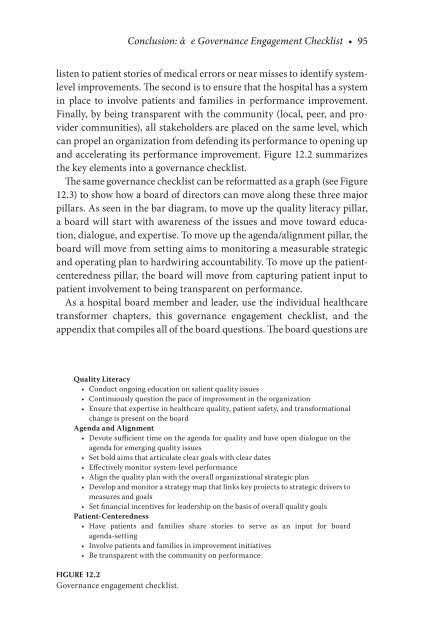Healthcare Transformation A Guide for the Hospital Board Member ...
Healthcare Transformation A Guide for the Hospital Board Member ...
Healthcare Transformation A Guide for the Hospital Board Member ...
Create successful ePaper yourself
Turn your PDF publications into a flip-book with our unique Google optimized e-Paper software.
Conclusion: ἀ e Governance Engagement Checklist • 95<br />
listen to patient stories of medical errors or near misses to identify systemlevel<br />
improvements. The second is to ensure that <strong>the</strong> hospital has a system<br />
in place to involve patients and families in per<strong>for</strong>mance improvement.<br />
Finally, by being transparent with <strong>the</strong> community (local, peer, and provider<br />
communities), all stakeholders are placed on <strong>the</strong> same level, which<br />
can propel an organization from defending its per<strong>for</strong>mance to opening up<br />
and accelerating its per<strong>for</strong>mance improvement. Figure 12.2 summarizes<br />
<strong>the</strong> key elements into a governance checklist.<br />
The same governance checklist can be re<strong>for</strong>matted as a graph (see Figure<br />
12.3) to show how a board of directors can move along <strong>the</strong>se three major<br />
pillars. As seen in <strong>the</strong> bar diagram, to move up <strong>the</strong> quality literacy pillar,<br />
a board will start with awareness of <strong>the</strong> issues and move toward education,<br />
dialogue, and expertise. To move up <strong>the</strong> agenda/alignment pillar, <strong>the</strong><br />
board will move from setting aims to monitoring a measurable strategic<br />
and operating plan to hardwiring accountability. To move up <strong>the</strong> patientcenteredness<br />
pillar, <strong>the</strong> board will move from capturing patient input to<br />
patient involvement to being transparent on per<strong>for</strong>mance.<br />
As a hospital board member and leader, use <strong>the</strong> individual healthcare<br />
trans<strong>for</strong>mer chapters, this governance engagement checklist, and <strong>the</strong><br />
appendix that compiles all of <strong>the</strong> board questions. The board questions are<br />
Quality Literacy<br />
• Conduct ongoing education on salient quality issues<br />
• Continuously question <strong>the</strong> pace of improvement in <strong>the</strong> organization<br />
• Ensure that expertise in healthcare quality, patient safety, and trans<strong>for</strong>mational<br />
change is present on <strong>the</strong> board<br />
Agenda and Alignment<br />
• Devote sufficient time on <strong>the</strong> agenda <strong>for</strong> quality and have open dialogue on <strong>the</strong><br />
agenda <strong>for</strong> emerging quality issues<br />
• Set bold aims that articulate clear goals with clear dates<br />
• Effectively monitor system-level per<strong>for</strong>mance<br />
• Align <strong>the</strong> quality plan with <strong>the</strong> overall organizational strategic plan<br />
• Develop and monitor a strategy map that links key projects to strategic drivers to<br />
measures and goals<br />
• Set financial incentives <strong>for</strong> leadership on <strong>the</strong> basis of overall quality goals<br />
Patient-Centeredness<br />
• Have patients and families share stories to serve as an input <strong>for</strong> board<br />
agenda-setting<br />
• Involve patients and families in improvement initiatives<br />
• Be transparent with <strong>the</strong> community on per<strong>for</strong>mance<br />
Figure 12.2<br />
Governance engagement checklist.











